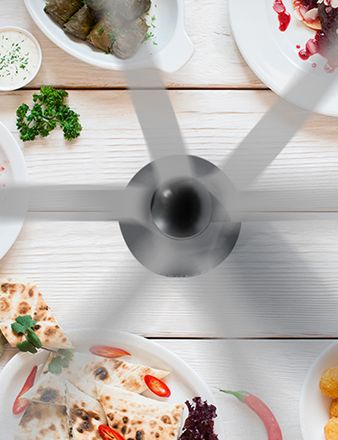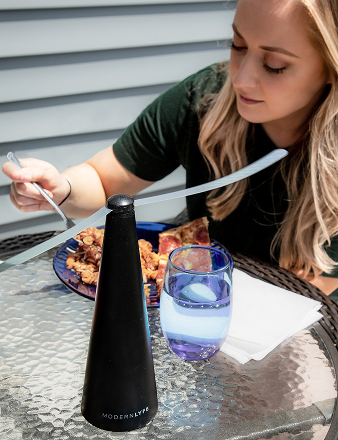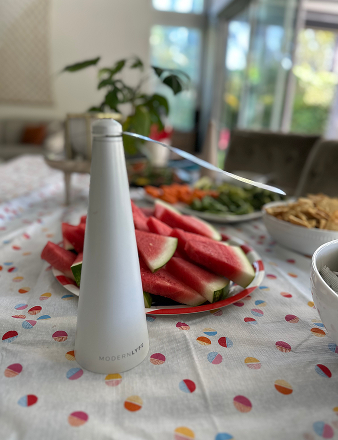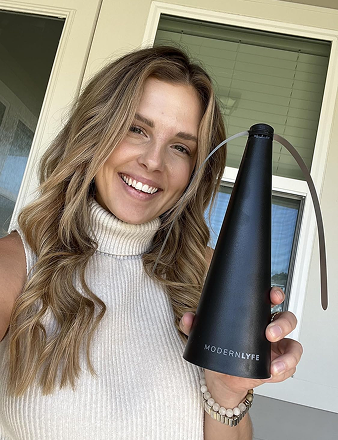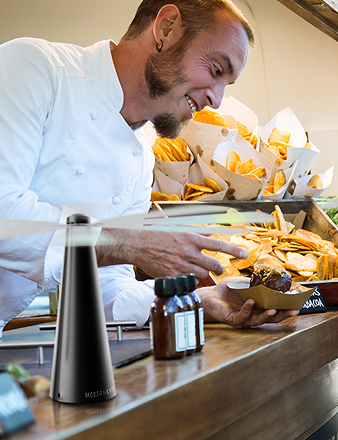Tired of flies crashing your patio dinners and backyard barbecues? Constantly swatting at pests when you’re trying to enjoy a meal is frustrating. A fly away fly repellent fan is a game-changer, offering a simple and effective way to keep your space fly-free without chemicals.
These fans don't just blow air; they create an invisible barrier that flies can't handle.
How Our Fans Create a Fly-Free Bubble
The technology behind a Modern Lyfe fly repellent fan isn't brute force. It's about outsmarting flies by using their own biology against them. This two-pronged approach creates an environment that flies are hardwired to avoid, which is why people are ditching smelly sprays and sticky traps for good.
Gentle Air Currents Keep Flies at Bay
First, it's about the airflow. The fan's soft blades spin to create a constant, gentle breeze. For us, it's barely noticeable. For a fly, it's like navigating a hurricane.
Flies are light and have delicate wings, making them clumsy flyers in anything but still air. The subtle turbulence from the fan makes it impossible for them to navigate and land, so they quickly give up and search for an easier target elsewhere.
The key is that the breeze is just strong enough to deter flies without blowing napkins off the table or cooling your food. It’s a silent, protective dome over your dining area.
Holographic Blades Confuse and Disorient
The second line of defense is visual. Our fan blades have special holographic patterns that reflect light. As the blades spin, this pattern creates a shimmering, constantly shifting light show.
A fly's compound eyes can't process this chaotic, refracted light. To them, it looks like a threat, triggering their instinct to flee. This combination of physical air disruption and visual confusion makes our fly repellent fans incredibly effective.
Why Fans Are a Smarter Choice
Let's be direct: traditional pest control methods for dining areas are not ideal. Sprays can be toxic, and traps are unsanitary. A repellent fan offers a clean, safe, and effective alternative.
Here’s a quick comparison:
Repellent Fans vs Traditional Pest Control Methods
| Feature | Fly Repellent Fan | Chemical Sprays | Fly Traps |
|---|---|---|---|
| Safety | Chemical-free, safe for kids & pets | Contains potentially harmful toxins | Unsanitary, attracts more pests |
| Effectiveness | Deters flies from landing | Kills on contact, but temporary | Catches flies, but can be slow |
| Placement | Directly on the dining table | Away from food, surfaces | Away from dining area, unsightly |
| Aesthetics | Modern and unobtrusive | Unpleasant odor, messy residue | Visually unappealing |
| Reusability | Reusable, battery-operated | Single-use can | Disposable, needs frequent replacing |
For a pleasant, fly-free meal, a modern repellent fan is the superior solution.
This shift away from chemicals isn't just a hunch; it's a massive market trend. The global fly repellent market was valued at $4.64 billion in 2023 and is expected to nearly double to $8.32 billion by 2030. This growth shows that people everywhere are demanding safer ways to protect their homes. You can see more data on the growing demand for fly repellent solutions on maximizemarketresearch.com.
Choosing the Right Repellent Fan for Your Needs
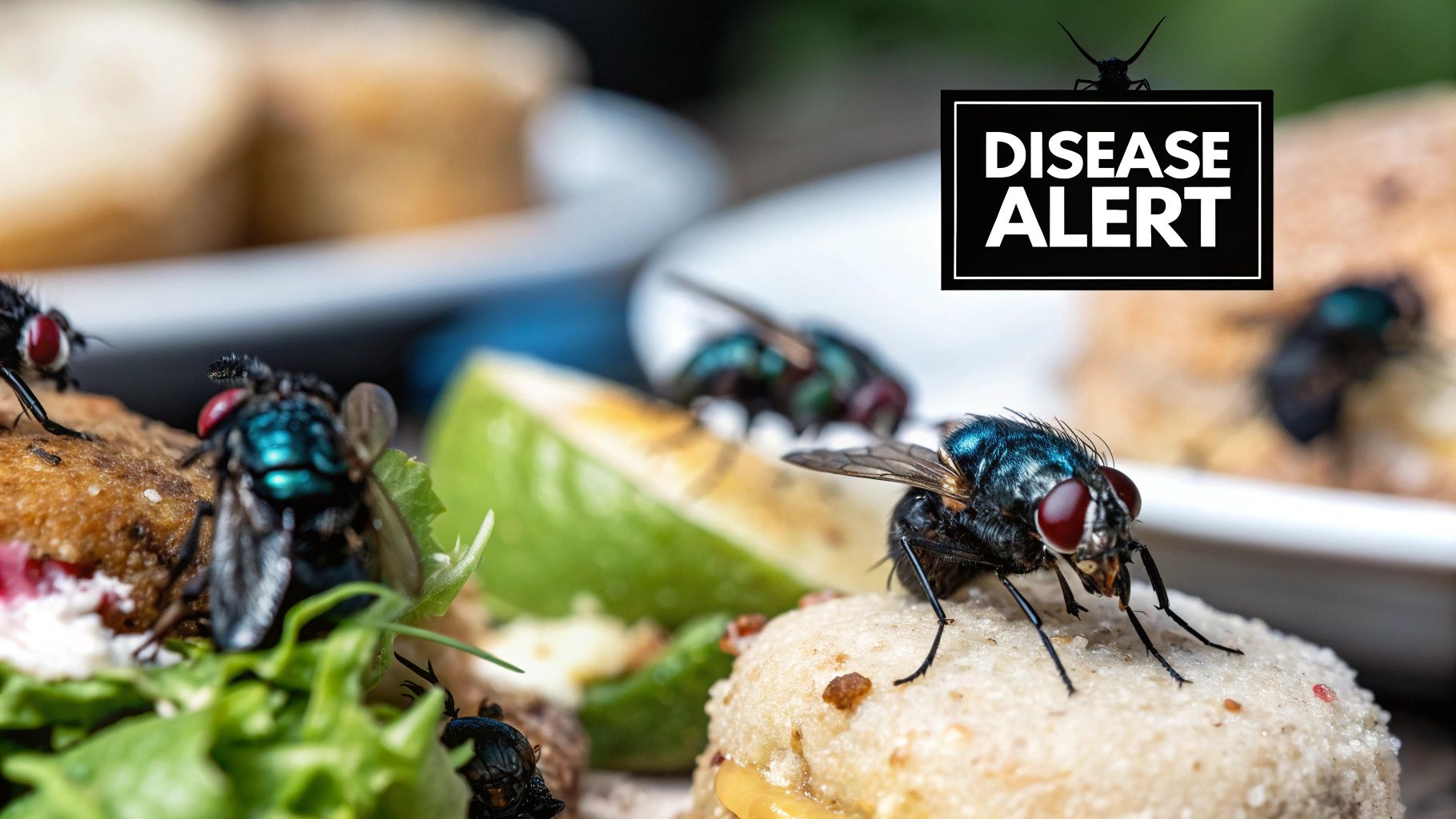
Picking the right fly repellent fan isn’t one-size-fits-all. The best fan for you depends on where you'll use it. Are you trying to keep flies off your blanket at the park, or setting up for a large dinner on the patio? The answer changes everything.
For on-the-go use—like camping, beach days, or tailgating—a lightweight, battery-operated fan is your best bet. These are built for grab-and-go convenience, giving you a fly-free zone without being tied to an outlet.
If your main goal is protecting a patio table near the house, a USB-rechargeable or plug-in model offers consistent power. You can set it and forget it, enjoying a long, relaxing meal without worrying about batteries dying.
Power Source and Portability
Your fan's power source determines its convenience. Match the power source to your lifestyle for a hassle-free experience.
- Battery-Operated: This is the king of portability. Perfect for picnics, camping, and any outdoor spot without an outlet. Always pack a spare set of batteries.
- USB-Rechargeable: These offer the best of both worlds. Charge it up for hours of cordless freedom, or plug it into a portable power bank for all-day use. They’re fantastic for backyard patios and outdoor events.
The real advantage of a Modern Lyfe fan is its versatility. Our USB-rechargeable models give you the freedom to go cordless when needed but also the reliability of continuous power for static setups.
Safety and Design Considerations
Beyond power, the fan’s design is a key consideration—especially with kids or pets around. The blade material is the most important safety feature.
Always choose a fan with soft, flexible blades. This is non-negotiable if little hands or curious paws might come into contact with it. These blades are designed to stop on contact, preventing any injury. It's a simple feature that provides total peace of mind.
To get into all the features, check out our complete guide on the best fly repellent fan. It will help you compare the details that make a big difference.
Placing Your Fan for Maximum Effectiveness
Even the best fly away fly repellent fan won't work well if it's in the wrong spot. Strategic placement is the secret to creating a bug-free bubble around your dining area. Think of it as creating overlapping zones of protection.
Where you set up your fan depends on the size and shape of your table.
- For a standard four-person table (round or square): One fan in the middle usually works. It creates a 360-degree dome of moving air that covers the entire surface.
- For a longer rectangular table: A single fan isn't enough. For a large family barbecue or buffet, you’ll have unprotected zones. The solution is to use two fans, placing one at each end. This creates two intersecting airflows for seamless coverage.
Finding the Sweet Spot
Get the fan close enough to guard your food without making it cold. The sweet spot is usually about 1 to 2 feet away from your plates. At that distance, the breeze is enough to disrupt a fly's flight path but won't ruin your dinner.
Also, pay attention to any natural breeze. If there’s a light wind, place the fan slightly upwind of your food. This way, the fan's airflow gets a boost instead of fighting against it, making your fly-free zone even stronger.
A common mistake is putting the fan too far away. Its power drops off quickly. Flies are crafty—they only need a tiny patch of calm air to land. Tight, comprehensive coverage is essential for a truly fly-free meal.

This image illustrates a simple, natural process, much like how our fans use basic principles of air movement to create an effective shield for your space. It’s a reminder that the best solutions are often the most straightforward.
Keeping Your Fan in Top Shape for Years to Come

To ensure your fly away fly repellent fan works perfectly every time, a little routine care is all it takes. This small investment protects your purchase and guarantees a fly-free zone for many seasons.
The most important task is keeping the blades clean. The holographic pattern disrupts a fly's vision, and any buildup of dust or grease will dull its effect. A quick wipe with a soft, damp cloth is all you need to keep the blades reflective and effective.
Smart Storage and Quick Fixes
When packing the fan away, proper storage matters. For a battery-operated model, always remove the batteries. This step prevents leaking battery acid, which can corrode internal parts and ruin the fan.
Even reliable gadgets can have issues. Here's a quick guide for common problems:
- Fan Won't Spin or is Slow: This is usually a power problem. Start by swapping in fresh batteries. If that doesn't work, check that the metal contacts in the battery compartment are clean. For USB fans, try a different power block or cable.
- The Fan Wobbles: A wobbly fan is usually on an uneven surface. Move it to a flat, stable spot. Also, double-check that the blades are fully extended and have clicked securely into place.
Taking care of your fan is more than just maintenance—it's choosing a smarter, more sustainable way to handle pests. As insects grow more resistant to chemical sprays, non-toxic solutions like a well-maintained fly fan become an indispensable tool.
This shift toward eco-friendly pest control is a direct response to insecticide resistance. Non-chemical devices offer a lasting solution that doesn't add to the problem or introduce harmful substances into our environment. You can explore more about this trend toward sustainable repellents on datainsightsmarket.com.
Creating a Fully Pest-Proof Outdoor Space

Your Modern Lyfe fly away fly repellent fan is the star, but a few other habits can turn your patio into a no-fly zone. Think of it as creating layers of defense. Your fan is the active protection, while a clean environment is the foundation that makes its job easier.
Start by removing things that attract flies. Keep food covered with mesh domes or lids until you're ready to serve. A spill, especially a sugary drink or BBQ sauce, can become a fly magnet, so wipe it up right away.
A common mistake is leaving an open trash can near the dining table. A can with a tight-fitting, secure lid is critical to keep food odors contained and stop flies from investigating.
Enhance Your Defense with Natural Scents
You can also make your space naturally unappealing to flies by using scents they hate. Many aromatic herbs we find pleasant are powerful repellents for them. Integrating these into your patio's landscape is a beautiful and functional strategy.
Try placing a few of these in planters around your seating area:
- Basil: This fragrant herb is a workhorse for deterring flies. A couple of small pots on the table or along the patio edge can make a noticeable difference.
- Mint: The sharp, fresh scent of mint is another great choice. It's easy to grow and handy for drinks.
- Lavender: Famous for its calming aroma, lavender is anything but for flies. It loves sun, so it's perfect for a pot on a sun-drenched deck.
When you combine the active air barrier from your fan with these simple, passive strategies, you build a more robust defense. To explore this layered approach, learn more about how to keep flies away outside in our complete guide. This powerful combination is the secret to keeping your outdoor gatherings peaceful and pest-free.
Have Questions About Fly Repellent Fans? We’ve Got Answers.
It’s a simple device, but asking questions before you buy is smart. You want to ensure you're getting the best fly-free coverage for your space. Here are the answers to the most common questions we hear.
Safety, Coverage, and All the Details
Are the blades safe around my kids and pets?
Yes. The blades are made of a soft, flexible material designed to be harmless. More importantly, a built-in safety feature instantly stops the rotation the second they touch anything—whether it's a small hand or a curious pet. You can set them on the table with total peace of mind.
How many fans do I really need for my table?
For a typical round or square table seating four to six people, one fan in the center is usually perfect.
If you have a longer rectangular table, use two fans. Place one at each end. This creates an overlapping zone of protection down the entire table, ensuring there are no weak spots for flies to enter.
Do they work on other bugs, like mosquitoes?
These fans were engineered specifically to disrupt the flight patterns of flies. While the air movement might annoy a stray mosquito, it's not a reliable way to keep them away. They are not effective against heavier insects like bees or wasps, who can fly through the gentle breeze.
Can I use them inside?
Of course. While they're a lifesaver for patios, they're just as effective indoors. Keep one on your kitchen counter next to the fruit bowl or to protect food while you prep a meal. They're whisper-quiet, so you'll barely notice they're running.
People are looking for smarter, chemical-free ways to deal with pests. The global fly repellent market is expected to grow by 5.8% annually, driven by a demand for safer alternatives. This shift shows how much people prefer a simple, effective solution like a fan, especially around food. You can dive deeper into these fly repellent market trends on archivemarketresearch.com.
Ready to take back your meals from annoying pests? The MODERN LYFE fly repellent fan is the simple, safe, and effective way to do it. Shop now and enjoy a fly-free experience.

